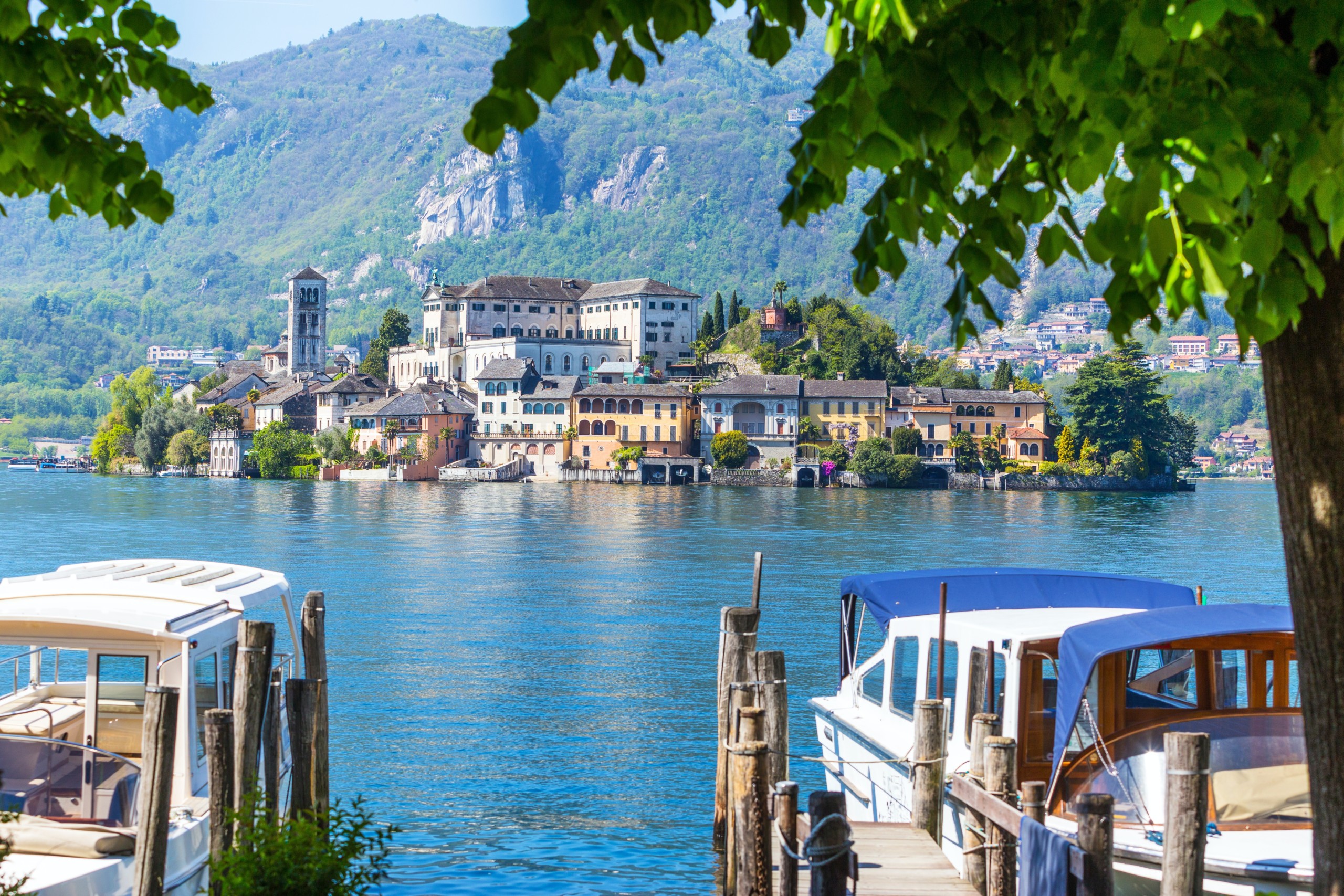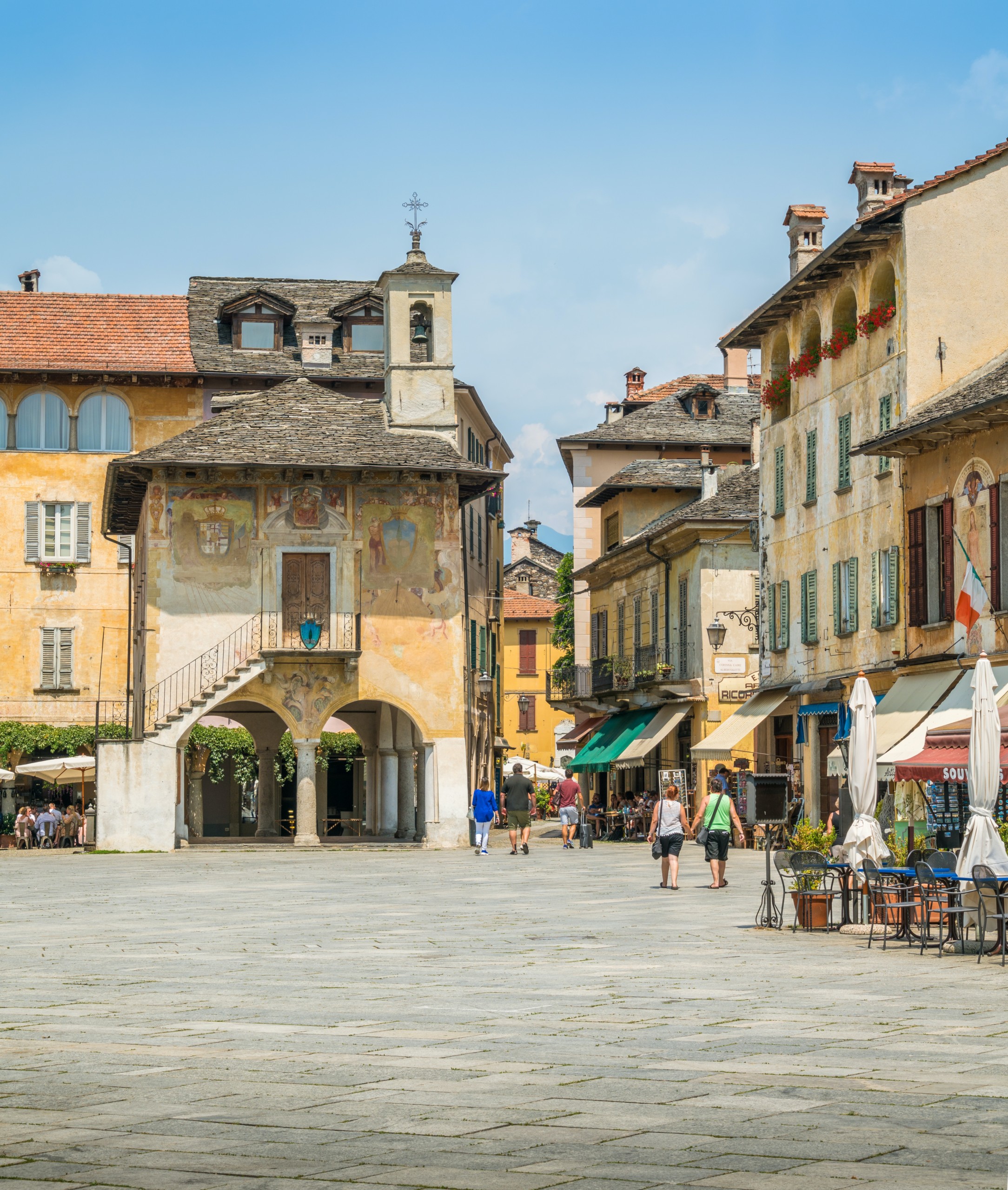Lago Orta’s Isola di San Giulio
Like a dream, ocher lights illuminate this island amidst a golden hazed sunset. Alpine born breezes carry the scent of jasmine and lemon blossoms. As if the lakes of Northern Italy could hold no more surprises, you discover Lago Orta. With more than 150 miles of shoreline, better-known Lago Maggiore, east of Lago Orta, dwarfs the twenty-one miles of Lago Orta’s lovely shores. Yet, this smaller island offers a peaceful retreat waiting for discovery.
History of Isola di San Giulio
In the midst of Orta’s crystal clear waters rests Isola San Giulio. During the 5th Century, the local patron saint, Julius of Novara, was buried on the island. Between the 6th and 19th centuries, subsequent improvements occurred on the island, most notably the seminary built at the end of the 12th Century. Also, the beginning of the 13th century saw the construction of a castle on the island.
In 1844, a convent was built on the ruins of the medieval fortress. Today, the Sisters of the Monastero Mater Ecclesiae, Convent of the Mother Church, reside and work. In cooperation with the Association of the Arts in Florence, these sisters repair priceless tapestries. Well after sunset, a number of them carry their completed work down to the water’s edge where they lovingly transfer the tapestry to a small boat and, from thence, to a truck on the mainland. Usually, the Sisters pick up yet another aged tapestry for repair.
To watch their small boat surreptitiously float across the midnight blue lake, a small lantern hung from the bow of their boat, is nothing short of breathtaking. You may also experience another an unusual gift — catching a glimpse of a white robed Sister during the day as she makes her way among the corridors and small bridges that cross the encircling paths of the island. They glide like phantoms from our imagination in a place of indescribable peace.
The Way of Silence and The Way of Meditation
The Sisters also tend to the task of maintaining the reverence of the island. In the latter part of the 19th Century, they created two pathways – the Way of Silence and the Way of Meditation. No matter the direction you circle the convent buildings, you will find signs which encourage you to stop and meditate on place and silence.
An example: “If you can be yourself, you are everything.”
Another reads as a poem.
Ascolta il silenzio
Ascolta l`acqua, il vento, i tuoi passi
Il silenzio è il linguaggio dell`amore
Il silenzio è musica e armonia
Listen to the silence
Listen to the water, the wind, your steps
Silence is the language of the love
Silence is music and harmony
Members of ancient religious communities etched notes in some of the frescoes on the main pillars of the Basilica’s nave. Inscriptions as mundane as the weather, jealousies between brothers ,and thoughts about their faith cover many of these treasures of Renaissance art. As visitors take time to study the labor of generations, all find reminders of those whose humanness reflects our own.
A Return to the Mainland
When you complete your visit to the island, you can retreat to the small village of Orta San Giulio. The medieval lanes of the town have changed little over the centuries. Though small, the Renaissance Town Hall dominates the main square, and the quiet of the tiny piazza is only interrupted by the occasional arrival of the parking area’s shuttle.
I admit a strong preference for staying along the shores of Lago Orta. This treasure — still not well known by visitors — provides a retreat for those seeking anonymity and escape from the tourist crowds. Far from cities, away from the madness of trains and buses, cars and ferries, visitors can treasure Lago Orta for its uniqueness — a place special and apart even in the midst of Italy’s northern lake region.
 If You Go
If You Go
You can easily reach Lago Orta by car from Lago Maggiore in about forty-five minutes. If driving, you must park above the village. Shuttle trains will carry you into the village center of Orta San Giulio. Once you ride through the perilously narrow lanes to get to the main square in the city, you will understand why you must park some distance from the village center!
From Milano Centrale Station, the best train connections arrive in the city of Gozzano, located at the southern end of the lake. From there, you can take a bus or taxi from the Gozzano train station to the ferry landing where you can purchase a ticket for travel on the lake.
Ferries on Lago Orta operate on a regular schedule throughout the day. The ferry offers a wonderful way to pass time here —a circuit around the entire lake requires only an hour’s trip. Gorgeous lake-side villas and small towns dot the shores and hillsides.
For schedules of the ferries on the lake, go to www.navigazionelagodorta.it.
Though visitors cannot enter the convent, visits to the Basilica and pathways of the island of San Giulio occur from 9:30AM – 12:15PM and from 4:00PM – 5:45PM. The Sisters who live on the island strictly enforce these hours, as they use the Basilica for their services. Photographs without flash are frowned upon, but permitted.
Places to Stay:
Hotel San Rocco
Residence La Casa Sul Lago
Also, check out the many apartments for rent around the lake. If staying for longer than a few days, these prove exceptional options, especially if you rent in a town with direct ferry service on the lake.



